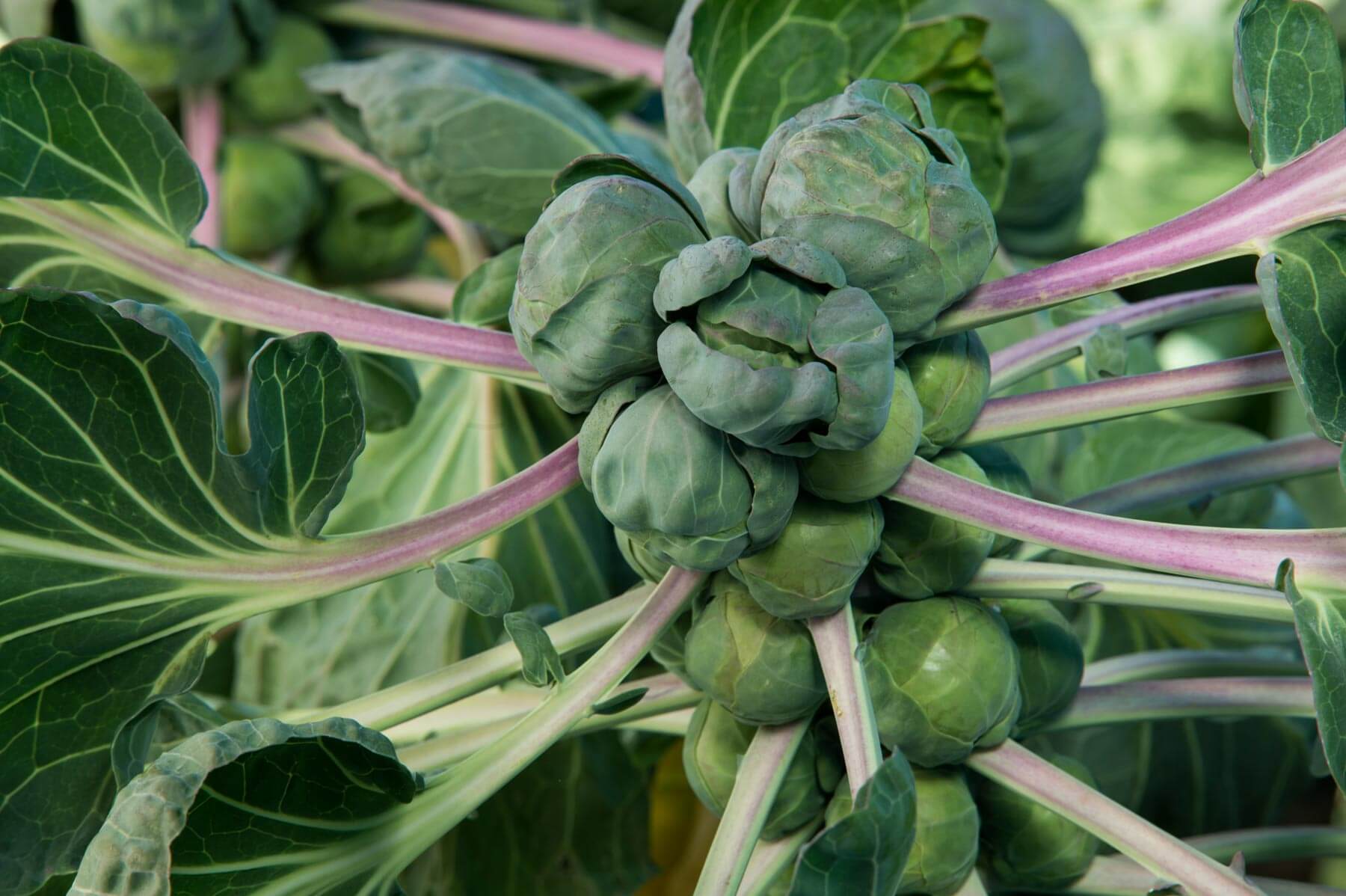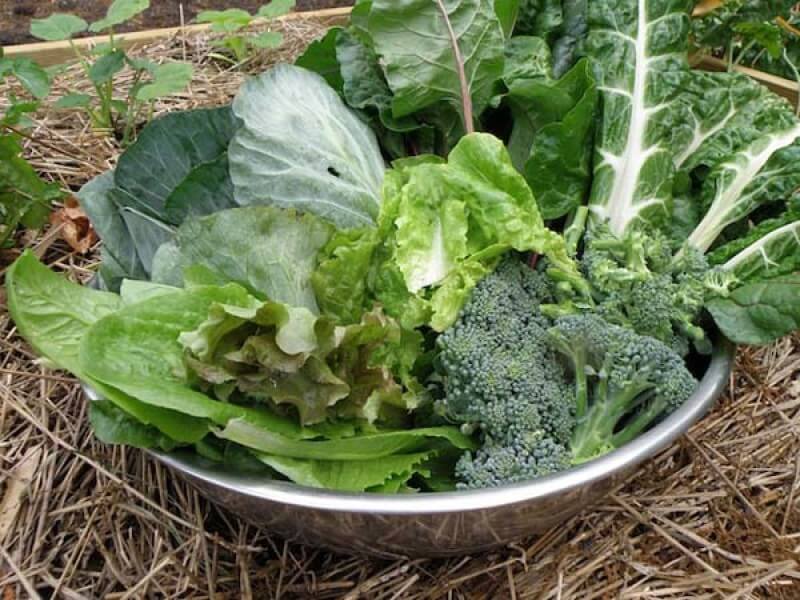Harvest your cool weather vegetables at the peak of perfection using these guidelines.
Broccoli
When you see a head beginning to form in the center of the plant, check its growth every day. Ideally, you harvest broccoli while the tiny buds are tightly closed. If the buds begin to swell or show yellow (the flower petals), cut the head from the stem right away, no matter how small it is, because the opening buds have a mealy texture. After cutting the main head, leave the plant to grow bite-sized side shoots in the axils of the leaves.
Don't be surprised if your broccoli head is smaller that those in the grocery store; they are grown in ideal conditions. Heads keep for about a week in the fridge.

Brussels Sprouts
Brussels sprouts are ready to harvest when the tiny heads are firm and about an inch in diameter. Remove by twisting them from the central stem.
Sprouts first form at the bottom of the plant and continue forming toward the top for several weeks. You can trick the sprouts to mature all at once by cutting off the top of the plant about six weeks before you want to harvest.
Full-grown sprouts keep well on the plant in cold weather, making them a great winter harvest item for gardeners in the South (planted in fall). In cold climates, gardeners often bury Brussels sprout plants up to their tops in hay or leaves in late fall, then pull off the little sprouts as needed through winter.

Cabbage
Cabbage is ready to harvest when the head forms. Some varieties hold well in the garden for weeks, while others need to be cut soon after the heads are firm. Our description of Bonnie varieties will indicate which hold best. If a head cracks, cut it right away.
Test the heads by squeezing them to see if they are solid. A head can look like it is ready from the outside, but still be flimsy and loose-leafed on the inside. Cut the head from the base of the plant.
Cabbage keeps for several weeks in the fridge.

Cauliflower
Check cauliflower every day as it approaches maturity. Leave the head to grow as long as it is small and very compact, until it reaches about 6 to 8 inches in diameter. However, if the head begins to open up, cut it from the plant at the base of the head, no matter how small it is, because it will only get looser and lose its characteristic texture. The head should keep in the refrigerator for at least two weeks. Cauliflower is a challenge to grow in many parts of the country because it is sensitive to temperature fluctuations.

Collards
Collards are ready to eat at just about any size; you simply cut off the lower leaves and let the plant grow more from the top. Regular harvesting and plenty of water will keep the plant growing fast to produce more tender leaves. The tastiest harvests are in fall and winter, when the leaves have been touched by frost.

Lettuce
Lettuce leaves are ready to harvest at just about any size. Pick leaf lettuce by breaking leaves one at a time from the outside of the plant; leave the bud to grow more leaves. You'll need to wait on Romaine lettuce to form its characteristic mid-rib before harvest; if left to grow to full size, it will form a loose, head-like clump of leaves.
Bibb types form a loose head that is ready anytime, but if you want the classic Bibb rosette, you will need to wait until the lettuce is nearly full grown and cut it at the soil line. The same is true for head lettuce; however, in climates where head lettuce doesn't make a firm head, you can harvest the leaves as they get large enough to eat.
Lettuce that matures in cool weather is the sweetest. As the weather warms, plants will go to seed. By the time they begin to stretch and send out a seed stalk, the leaves are often bitter. When this happens, harvest all your lettuce at once and store it in the refrigerator.

Onions
When onion tops begin to yellow, it is a sign that they are just about mature. At this time, stop watering and let the bulb tops fall over and dry. Then the onions are fully mature and ready to be pulled up. Don't be tempted to pull the onions too early, because the thick, moist neck becomes a breeding ground for rot.
After pulling the onions, spread them out (without touching each other) in a shaded, dry place to cure for a few days. Then cut the tops back to about 1″ and clip the roots.
A good way to store onions is in a nylon stocking. Just drop them in one at a time, tying a knot between each one to keep them separated. Hang them on a nail in a cool, dry place and clip off onions as needed. Onions also store well spread out on a screen. Just be sure to allow space between each one.

Snap Peas
You can harvest sugar snap peas just about any time. The peas and the pods are very sweet, making these one of the best peas ever. They are so delicious whole that the harvest may never make it to the kitchen.
If you pick the pods while they are still young and flat, you can use them in stir-fry like Chinese edible pod peas. Or you can wait until the peas inside fill out and eat the pods whole, or shell them to eat the peas inside just as you do English peas.
Be sure to eat these right away after picking, because the sugar that makes them so sweet soon turns to starch. Pinch the pods from the vine at the stem. Don't tug because pea plants hang on to their support with thin little tendrils that are easy to rip.

Spinach
Spinach leaves are ready to harvest just about anytime that they are big enough to eat. You can pluck outer leaves one at a time, leaving the small center leaves in place to grow. Or you can wait until the plants are well filled out and pull up the entire plant, cutting away the roots. In spring, keep plants in the ground until they begin to stretch, or go to seed.
In fall, leave the plants in place. In mild climates, they produce all winter. In cold climates, some gardeners raise plants in a cold frame or cover them with hay and leave them to produce a very early spring harvest.





 Herbs
Herbs
 Vegetables
Vegetables
 Fruit
Fruit
 Flowers
Flowers
 Succulents
Succulents


